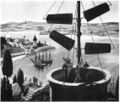Template:Selected anniversaries/March 2: Difference between revisions
No edit summary |
No edit summary |
||
| Line 39: | Line 39: | ||
||1962 – Charles Jean de la Vallée-Poussin, Belgian mathematician and academic (b. 1866) | ||1962 – Charles Jean de la Vallée-Poussin, Belgian mathematician and academic (b. 1866) | ||
||Henrietta Bolt | |||
File:Pioneer 10 construction.jpg|link=Pioneer 10 (nonfiction)|1972: The ''[[Pioneer 10 (nonfiction)|Pioneer 10]]'' space probe is launched from Cape Canaveral, Florida with a mission to explore the outer planets. | File:Pioneer 10 construction.jpg|link=Pioneer 10 (nonfiction)|1972: The ''[[Pioneer 10 (nonfiction)|Pioneer 10]]'' space probe is launched from Cape Canaveral, Florida with a mission to explore the outer planets. | ||
| Line 44: | Line 46: | ||
||1995 – Researchers at Fermilab announce the discovery of the top quark. | ||1995 – Researchers at Fermilab announce the discovery of the top quark. | ||
||Jordan Carson Mark ( | File:Jordan Carson Mark.gif|link=Jordan Carson Mark (nonfiction)|1997: Mathematician [[Jordan Carson Mark (nonfiction)|Jordan Carson Mark]]. He was the leader of the Theoretical Division at the Los Alamos laboratory, where he oversaw the development of new weapons, including the hydrogen bomb in the 1950s. | ||
||1998 – Data sent from the Galileo spacecraft indicates that Jupiter's moon Europa has a liquid ocean under a thick crust of ice. | ||1998 – Data sent from the Galileo spacecraft indicates that Jupiter's moon Europa has a liquid ocean under a thick crust of ice. | ||
Revision as of 18:20, 28 February 2018
1453: Doctor, astronomer, and astrologer Johannes Engel born. He will publish numerous almanacs, planetary tables, and calendars.
1791: Long-distance communication speeds up with the unveiling of a semaphore telegraph machine in Paris.
1911: Astronomer, physicist, and mathematician Arthur Eddington builds new type of scrying engine which detects and prevents crimes against mathematical constants.
1972: The Pioneer 10 space probe is launched from Cape Canaveral, Florida with a mission to explore the outer planets.
1997: Mathematician Jordan Carson Mark. He was the leader of the Theoretical Division at the Los Alamos laboratory, where he oversaw the development of new weapons, including the hydrogen bomb in the 1950s.
2017: Famed gem detective Niles Cartouchian captures supervillain Fugitive Rubies.





